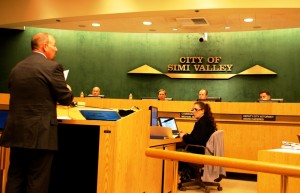 False statements and illegal taping plague Simi Valley planning commission meeting
False statements and illegal taping plague Simi Valley planning commission meeting
When the Simi Valley City Council meeting adjourns tonight, it will most likely ink its approval of a five-year extension of KB Home’s option to build 461 homes in 1,595 acre Runkle Canyon.
That might not be such a bad idea.
With two years left on its original extension, the developer would have until the summer of 2019 to build out the project which has been mired in controversy since EnviroReporter.com exposed high strontium-90 readings in Runkle Canyon’s environmental impact report in March 2005.
[KB Home’s Runkle Canyon development is now called Arroyo Vista at the Woodlands]
Tonight’s decision will follow an extraordinary June 24 planning commission meeting where the five Simi Valley commissioners voted unanimously to green light the added time for the Westwood-based construction giant. Council members have already expressed support for the extension.
Runkle Canyon has been plagued by reports of high radiological, chemical and heavy metal contamination in the canyon since March 2005. The property borders the radioactive and chemical polluted nuclear Area IV of the 2,850-acre Santa Susana Field Laboratory, commonly known as Rocketdyne.
KB Home was determined not to see a repeat of its disastrous presentation at the last planning commission meeting May 23 (See “Runkle Canyon Tanks” June 1, 2012). Tom DiPrima, KB Home lead man on the project, brought a bevy of ‘experts’ who were supposed to shore up the corporation’s contention that the picturesque property is pollution-free.
But every dust cloud has a silver lining, even if it’s a strontium-90 infused one. It comes in the form of passage in the Agenda Summary for tonight’s city council meeting:
4. PUBLIC HEARINGS: NOTE ON PUBLIC NOTICE: This is the time and place set for a public hearing on the consideration of matters as presented on this agenda. Let the record show that due notice was given as required by law and an affidavit to this effect is on file in the Office of the City Clerk. The reports of the City Staff relating to these matters shall be made a part of the record of this meeting. NOTE ON JUDICIAL REVIEW: If you challenge in court any of the City Council decisions made here tonight, you may be limited to raising only those issues you or someone else raised at this public hearing. The time within which judicial review must be sought is governed by California Code of Civil Procedure Section 1094.6. [Our emphasis]
Thanks to the superb filming capabilities of the city’s city council chambers which include a comprehensive archive of past city council and planning commission meetings, tonight’s meeting will record the introduction of Runkle Canyon’s contamination issues since we first began reporting on them March 2005 for Los Angeles CityBeat & ValleyBeat.
This reporter will give the city clerk a binder with our Runkle Canyon media coverage as well as our comments to DTSC on the project as well as the comments of others that submitted them as well. Those comments were never answered by DTSC. Instead the residents and this reporter were treated to a form letter which didn’t address the comments.
The coverage will include this article which documents the June 20 planning commission meeting.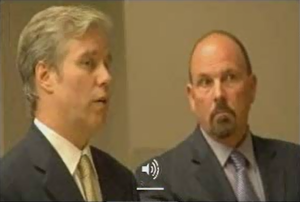
DiPrima, sensitive to charges that he, in his own words, “lied” to the commission at the May 23 meeting, made sure that he was prepared for the June 20 meeting and had the people to prove it.
That preparation may have backfired, however, because DiPrima and company repeatedly mischaracterized the testing of the site inadvertently giving ammunition to any future fighting over the site’s environmental condition in court.
There the supremacy clause, a rule that allows federal law to supersede state law, might be applicable regarding the Clean Water Act and surface water runoff in Runkle Canyon and Runkle Canyon Creek. Not only has the developer ignored 2003 and 2004 Los Angeles Regional Water Quality Control Board (LARWQCB) demands that it tests Runkle Canyon’s surface water, so has the city’s planning department.
KB Home’s presentation began with pleasantries from former planning commissioner and vice chair of the Ventura County Republican party, Dean Kunicki. “We need to rely on the truth,” Kunicki said. “We need to rely on the facts and we have to have some common sense in this case. Not on conjecture, not on innuendo and certainly out of context comments.”
Facts immediately began to take a holiday. DiPrima stepped to the microphone and pronounced that the LARWQCB signed off on project with other agencies. “Their conclusions after reviewing countless data on this site that it is safe for future residential,” DiPrima said. “Not only did we test the soil here, for years we have tested the surface water, the groundwater and though we’re not using the groundwater here for the site, that testing resulted in the 2007 Regional Water Quality Control Board, stating in their letter, that ‘no further tests of the site are necessary and approved the abandonment of the existing wells.’”
But that April 5, 2007 California Regional Water Quality Control Board letter actually states:
Based on groundwater sample analytical results for perchlorate, VOCs, and n-NDMA, the Regional Board has no further requirements for this site, monitoring wells may be abandoned in accordance with the California Department of Water Resources Bulletins 74-8 and 74-90 California Well Standards. [Our emphasis]
So if DiPrima and KB Home believe that parsing a letter dealing exclusively with groundwater to interpret it to cover Runkle Canyon surface water as well, it may be that they didn’t parse closely enough. The passage says “no further requirements for this site” meaning that the LARWQCB’s 2003 and 2004 requirements for a full suite of tests done on Runkle Canyon Creek water still must be done or KB Home will be violating the Clean Water Act.
DiPrima went on to cite a discredited 2005 study that even the government disowned saying, “In 2005, resampling of five locations in the open space taken again this time directed and overseen by the California Department of Public Health; splits were analyzed and the Department of Public Health test results were much lower than the 1990 [sic] test results.”
But the lower results were tossed by the department as not being of much use because of the high detection level.
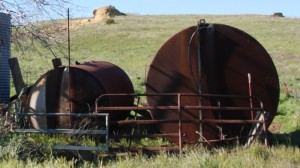 DiPrima went on to talk about the windmill well as if he had never repeatedly said to the commissioners at the previous planning meeting that there were no tanks at the well. “Our opponents at the last meeting said there was TCE in this well,” which is inaccurate – concerned citizens had noted it had been found in the past, not that it was currently in the well. He went on to add that preliminary results in a recent round of testing show no TCE “above 2.0 parts per billion, the reporting limit, which would subject that as a non-detect.”
DiPrima went on to talk about the windmill well as if he had never repeatedly said to the commissioners at the previous planning meeting that there were no tanks at the well. “Our opponents at the last meeting said there was TCE in this well,” which is inaccurate – concerned citizens had noted it had been found in the past, not that it was currently in the well. He went on to add that preliminary results in a recent round of testing show no TCE “above 2.0 parts per billion, the reporting limit, which would subject that as a non-detect.”
Defying logic and simple science, DiPrima departed on a rhetorical odyssey explaining how where the houses are to be built, a couple of miles from the Runkle Canyon and Rocketdyne border, should show the highest signs of contamination instead of the property line bordering Area IV where huge hits of strontium-90 have recently been detected by the US EPA yards from the Runkle property.
“Keep in mind one thing,” DiPrima began. “Let’s say you have a scenario, because I’ve heard by the opponents that the water runs right through this canyon. It’s not going to stop at the middle of the hill. If it would have settled anywhere, it would have settled at the bottom of the hill on the homes that are right here. We know we’re not seeing issues here, if it’s runoff, it doesn’t stop at a chain-link fence. It keeps moving and the most exposure would have been here because remember that bridge wasn’t here for many many years so it would come down in (arroyo) area and collect. From a surface water perspective.”
Convoluted explanation aside, Runkle Canyon Creek runs down into the Arroyo Simi and not where homes are. DiPrima then went on to describe an elaborate set of surface water tests, the results of which are unknown to this reporter probably because they may not exist. The Department of Toxic Substances Control says that it only took two surface water samples, miraculously devoid of any contaminants including no arsenic at all, but nothing like what DiPrima paints.
“We came back when it was raining,” DiPrima told the commissioners, “Waited until we had a storm event where we had water running on our site and working with DTSC we said ‘don’t just test in the one spot; test it all the way to where it goes to the end because I don’t want to hear that we tested here and oh it washed down. We tested all the way down.’”
DTSC has never mentioned any such tests.
This angered residents like the Reverend John Southwick of the Radiation Rangers. Southwick has fought for a full and believable characterization of the creek and other areas of Runkle Canyon since 2006.
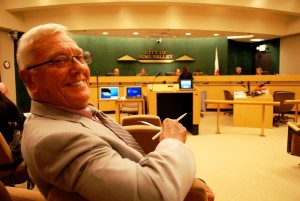 “Since when is lying to the commissioners an acceptable way of doing business?” Rev. Southwick asked the commission. “It just is not right. You asked, Commissioner Bibb, what it is that we would like. We would like to see a supplemental EIR. You get two years to do it. Obviously they’re going to willing to pay for it. If it comes back clean I’m willing to be the liaison between KB Home and the city. I’ll get some other folks that can be trusted.”
“Since when is lying to the commissioners an acceptable way of doing business?” Rev. Southwick asked the commission. “It just is not right. You asked, Commissioner Bibb, what it is that we would like. We would like to see a supplemental EIR. You get two years to do it. Obviously they’re going to willing to pay for it. If it comes back clean I’m willing to be the liaison between KB Home and the city. I’ll get some other folks that can be trusted.”
When it came to trusting someone at this meeting, the commissioners certainly put their confidence in Dewey Runkle a direct descendant of the first Runkle to purchase the property in 1913. Runkle spoke to the issue of the tanks
“We used it for cattle storage water,” Runkle told the commissioners. “The windmill only pumps a little bit at a time so it pumps in, it comes in, goes in to the tanks and then the bigger tank it goes in and when it fills it there’s a hose that went over to the little one to fill it and then, of course, on the bottom there’s pipes going over to the water trough that would be below it.”
Very convincing testimony. Yet photos clearly show that there are no pipes coming out of the bottom of these tanks, though they run alongside it unconnected, as one would expect if they actually were used for watering cattle. They only are open at the top.
Nonetheless, commissioner Scott Santino took this statement, which was either incorrectly remembered or a factual inaccuracy, as gospel truth when he made his key decision to vote for the extension.
“I thought that the tanks were the smoking gun,” Santino said. “To have Mr. Runkle come up here tonight and say ‘Yeah, my family put them up there.’ This is the owner of the property. This is Mr. Runkle. This isn’t his third removed nephew. This is the man so when I saw him my jaw dropped to have him answer my personal question ‘what were the tanks for?’ ‘They were store the water. They were to feed our cows. I could see the trough there. I have to tell you that was impactful to me to hear the man who has been on that property, what the family has owned it [since] 1914. So for me, I haven’t seen anything to preclude this going forward at this point.”
Certainly not the facts – Santino claimed he had climbed all over the tanks in a jaunt up to the windmill well with Commissioner Rice courtesy of DiPrima. Even with a little flashlight and camera, somehow Santino, who claimed to be a hydrologist, missed the fact that the tanks have no way to let the water out once it’s put in save for sucking it out with a tube, a technique most well known as the way to siphon a gas tank.
“The first thing I know about hydraulics is if you’re going to inject a pressurized system into a pressurized system, this motor better be stronger than that motor and there is no motor on the tanks,” Santino said. “It’s a well, an old style well that’s driven off of the wind and it’s still functional. It still goes up and down. Whether it pumps water, I can’t tell you but the point being when I looked at all piping I thought, I was thinking ‘What would be the purpose? Why would somebody fill up this tank with some kind of chemical, a contaminate, to put down the well. I got to be honest. Just pull the plug on the tank and drain on the grass. It would be easier.”
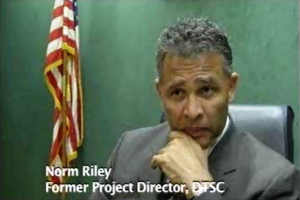 DiPrima’s biggest gamble was to bring the former DTSC Runkle Canyon and Rocketdyne project director Norman Riley to the podium. Riley, who served in that capacity from April 2007 until October 2009, was the controversial figure greeted enthusiastically by the community at first but Riley was soon became at odds with longtime activists for his perceived toadying to SSFL lab owner Boeing as well as KB Home (See “Riley’s Revenge,” September 15, 2009).
DiPrima’s biggest gamble was to bring the former DTSC Runkle Canyon and Rocketdyne project director Norman Riley to the podium. Riley, who served in that capacity from April 2007 until October 2009, was the controversial figure greeted enthusiastically by the community at first but Riley was soon became at odds with longtime activists for his perceived toadying to SSFL lab owner Boeing as well as KB Home (See “Riley’s Revenge,” September 15, 2009).
Yet despite being sacked nearly three years ago, and having nothing to do with the subsequent 2010 testing, Riley imparted a litany of factual inaccuracies all the while presenting himself as if he still working for DTSC. Riley also falsely claimed that he himself had signed the No Further Action notice, when in fact he had been ‘retired’ for over a year when the NFA was inked. The pomposity of Riley’s false portrayal worked perfectly with the commissioners who hung on his every word.
“We don’t simply take the information and take it at face value,” Riley intoned. “We look behind the data. We ask whether the samples were properly collected, whether they were properly preserved, whether they were properly tested and whether the results are therefore believable.”
Riley became less ‘believable’ as he went on, even as commissioners started shifting in their seats. Indeed, Riley was reading from prepared text meaning that his misuse of the present tense was no mistaken misunderstanding of English grammar.
“Well, we DTSC [sic] did some additional testing in an effort to confirm whether those results were real or whether they were not. We purposely, intentionally went to locations where we thought we’d get the highest results, locations where the high results came from in 1999. No high results were found.”
But Riley went nowhere with DTSC to do additional testing because he already was long gone from DTSC. The vengeful retired DTSC man saved the best of the worst for last.
In the video to the left, Norman Riley testifies at the Simi Valley Planning Commission meeting on June 20, repeatedly presenting himself as if he still worked at DTSC and stating that he issued the NFA determination (minute 14:58) though he was no longer at the agency at the time it was issued.
“DTSC is satisfied that the property is safe for unrestricted residential use that’s why I issued a No Further Action determination,” Riley said, knowing full well he didn’t sign the NFA – DTSC’s actual Runkle Canyon Project Manager Mark Malinowski did. “We don’t do that sort of thing carelessly and we certainly don’t do it because we are controlled by entities like KB Home.” (*Update – Riley was more clear about who he worked for at the subsequent July 16 City Council meeting, stating, “I am here tonight on behalf of Runkle Canyon LLC.”)
Again, the royal ‘we’ indicating continued employment by DTSC when, in fact, KB Home arranged for Riley to come to Simi Valley to spread spout factual inaccuracies to the planning commission long after he had left DTSC.
Were these “factual inaccuracies,” a term coined by KB Home attorney Preston Brooks at a previous planning commission meeting, or was it flat out lying enabled by the fact that Riley wasn’t sworn in? Whatever it was, Riley was not to be outdone by DiPrima as KB Home came down the home stretch in their response to comments of the public, including this reporter’s brief words to the commission.
“I’ve been accused many times of lying tonight,” DiPrima said. “In fact I heard Mr. Collins say that we denied access, Runkle Canyon LLC denied access to the Regional Water Quality Control Board and he [Collins] never lies. In 2004, we didn’t even own the property, we didn’t even know anything about the property.”
As can be heard on the city’s recording of the event, I never made such a claim. DiPrima spun this out of thin air with no basis in truth or reality. DiPrima also resorted to twisting the words of Malinowski as he pointed at this reporter: “The opponents have reached out – I have an email from Mark Malinowski – to the opponents actually saying ‘we’ve consulted with USEPA and we see no reason to rescind the NFA.’”
While true Malinowski consulted with USEPA about the new radiological and chemical concerns regarding Runkle Canyon, the federal agency gave neither a thumbs up or thumbs down. Indeed, a source close to USEPA told EnviroReporter.com July 15 that the agency was to maintain a “hands off” stance towards this latest round of debate over whether KB Home should be granted a five-year extension.
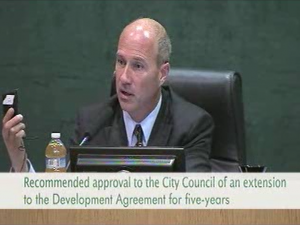 KB Home and DiPrima’s extraordinary efforts to sway the Planning Commission were aided by amateur filmmaker and activist Adam Salkin, who assembled a camera-toting crew and secretly wired the dais with microphones for sound without informing the commissioners. That’s against California law.
KB Home and DiPrima’s extraordinary efforts to sway the Planning Commission were aided by amateur filmmaker and activist Adam Salkin, who assembled a camera-toting crew and secretly wired the dais with microphones for sound without informing the commissioners. That’s against California law.
When the commissioners realized that their private conversations with each other had been covertly recorded, several of them went understandably ballistic and subsequently voted unanimously to approve the extension.
As the public part of the meeting closed and the floor was open for the Simi Valley Planning Commission to makes its decision, it became clear just how extensive and damaging Salkin’s intrusion into the Runkle Canyon issue was for the residents of Simi Valley. Salkin’s repeated attempts to secretly film the commissioners were laid bare as was the harm done to the public process by these illegal activities.
Influential swing vote, Commissioner Santino, addressed Salkin who sat in the front row of the audience easily identifiable by his long ponytail and backwards-facing baseball cap.
“Well, anyhow I agreed to meet Mr. Salkin, watch a 30 to 40 minute presentation, myself and Commissioner Rice, and we sat in the room to watch it and without any notice to us, you showed up with your cameras and I said ‘You know I’m not comfortable.’” Santino said, successfully controlling his anger. “Now I understand; KB Homes said ‘Can we sit in to observe what they’re going to show you so we know how to rebut?’ I said that’s fair. [In] a court of law, when you present your case, you have to let the opposing team know what you’re doing, okay? Perry Mason is different but in real life it’s not. It would not be fair to sandbag them and just as well I wouldn’t let them do that and they weren’t allowed to ask any questions or do anything. They were merely observers. But my point is I asked you to take away the cameras and we started reviewing your piece there, your report, and what happened? Within five minutes, I had to demand that your cameraman stop because he was surreptitiously filming us. He had his camera at an angle and all the lights were on. Sir, I did not like that. I thought that was very unprofessional and it goes to my point tonight. Again, this is all for the public to see. This is broadcast on the web. It’s archived. People at home can watch it. We’ve allowed you guys to film. Halfway through the meeting tonight, I realize buried in the wires up here is a microphone. No one asked me if this microphone could be up here. Excuse me. And when we’re discussing things in between agenda items, you were recording us. I don’t think that’s appropriate, sir. You did not ask me, I can tell you that.”
The commissioners, this reporter and even the activists in the audience sat in stunned silence. Salkin had managed to destroy the credibility of the community with yet another secretive audio taping of non-consenting adults much as he had done to this reporter in May.
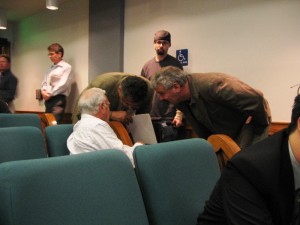 Indeed, this reporter took photographs of Salkin illegally recording the confidential conversation of Norm Riley, the Reverend John Southwick and former Simi Valley resident Frank Serafine March 27, 2008 at a meeting of the former Santa Susana Field Laboratory Workgroup at the Simi Valley Cultural Arts Center.
Indeed, this reporter took photographs of Salkin illegally recording the confidential conversation of Norm Riley, the Reverend John Southwick and former Simi Valley resident Frank Serafine March 27, 2008 at a meeting of the former Santa Susana Field Laboratory Workgroup at the Simi Valley Cultural Arts Center.
Salkin did admit culpability at the planning commission meeting. “I didn’t ask you [for permission to audiotape],” Salkin said responding to Santino. “I just put microphones here so we could capture sound, that’s all.”
But that’s not all. The commissioners were clearly angered by the sneaky law-breaking, bold even by Salkin’s slippery standards.
“I am so mad about this, I’m having problems thinking,” Commissioner Mary Bibb said through repeated interruptions by Salkin who was eventually silenced by Planning Commission chair Michael McGuigan who threatened to throw him out of the meeting chambers if he didn’t stop.
“First of all nobody told me that I was being taped and I really really resent that,” Bibb said, voice quavering. “It is illegal to tape somebody without notifying them.”
Within minutes, the commission voted unanimously to recommend granting KB Home the additional five years to build its Runkle Canyon development.
Tonight’s meeting will most likely codify this recommendation. After all, three of the councilmembers were present in 2004 when the original Runkle Canyon EIR was approved by them. These councilmembers, Glen Becerra, Steve Sojka and Barbra Williamson, all voted in favor of the project then even though they neglected to mention that they might have a conflict of interest since they had accepted thousands of dollars in campaign contributions from the developer at the time, GreenPark Runkle.
Approving this project will bring full circle the lethargy of government regarding the Runkle Canyon development project. That lethargy did not extend, however, to the hostility that government regulators and politicians have had towards the letter of environmental law and the citizens concerned about it.
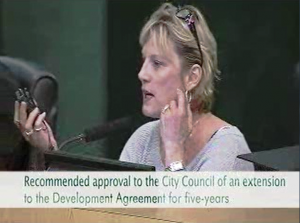 Those citizens have a powerful recourse, one where false statements under oath are rewarded with a trip to the pokey. “My feeling is if we go through this five year extension, you have seven years to sue them,” Commissioner Bibb added before she voted for it.
Those citizens have a powerful recourse, one where false statements under oath are rewarded with a trip to the pokey. “My feeling is if we go through this five year extension, you have seven years to sue them,” Commissioner Bibb added before she voted for it.
Nine days after the vote, DTSC’s new test results from the windmill well came back positive for the manmade chemicals Toluene and Naphthalene, both toxins though some government agencies here and abroad consider both chemical carcinogenic. It is unlikely that any method of well contamination by these chemicals exists other than them having been introduced to the well manually. That means they had to be poured into the well.
Regardless of potential legal challenges to the city and KB Home, residents can take comfort in the fact that potential future residents and open space users will have ready access to the scientific and political truths about Runkle Canyon via the Internet.
While the developer and government may have failed the community it disregards with hostility, the truth remains. The law of land, like the Clean Water Act, reign supreme in this country. Local traditions of obfuscation, misrepresentation, and gross negligence do not trump the federal laws and regulations of the United States of America.
24 Years of Award-Winning SSFL/Rocketdyne Reporting
June 1998 – June 2022












@KB Home Sucks: KB Home calls its Runkle Canyon development Arroyo Vista at the Woodlands. Look here soon for major new developments regarding Runkle Canyon which abuts Area IV of the Santa Susana Field Laboratory.
I think it’s unbelievable that this company is going to be building homes near this site. I think this is a new all time low for this company. I hope there will be lots of protests. http://KB-HomeSucks.com
How much radiation is in the soil in city of Chatsworth?
I note, for the record, that DTSC’s employees issued their No Further Action Letter concerning Runkle Canyon during the final months BEFORE Governor Brown took office in January 2011.
During that final month, or perhaps earlier, DTSC’s Interim Director Maziar Movassaghi apparently learned that he would not be appointed by Governor Brown as permanent Director of DTSC. In addition, during that same time period Mr. Movassaghi’s right-hand-man concerning Santa Susana Field Lab apparently learned that he would be “given a new assignment” in DTSC’s hierarchy once Governor Brown’s new DTSC Director took office. (The latter fellow was the one who “threw” his deposition in Boeing’s lawsuit against the State concerning SSFL, saying that the Legislature did not need to pass the law Boeing sought to invalidate, that the Legislature wanted to interfere with DTSC’s exercise of its discretion and that in passing the law Boeing opposed the Legislators unnecessarily ignored DTSC and pandered to everyone’s favorite expert Dan Hirsch. To use an old line, with friends like that the Legislature and the public don’t need to look for enemies.)
I’ve looked at a lot of online DTSC Envirostor documents concerning a multitude of DTSC remediation projects since Governor Brown was inaugurated. The dates of documents posted on Envirostor make it is very clear that back in December 2010 DTSC’s senior employees could be politely characterized as a “making a mad rush” to do as many favors as possible for polluters and their environmental lawyers. The “fast and dirty” issuance of approvals by DTSC staff members in December 2010 crosses a broad spectrum of projects under DTSC’s jurisdiction.
It’s very sad when State of California or local government employees act in a dishonorable way in protecting the public health, because what they are obviously angling for, in some cases, is a lucrative consulting gig after their “retirement” from the State’s employ. For example, the LA-Ventura Regional Water Quality Control Board’s long time Executive Director is now “in the private sector” and doing legal work for clients whose goals are the antithesis of protecting the publicly owned water supply under the Porter-Cologne Water Quality Act. And then, of course, there’s Mr. Riley.
Truly gut-wrenching, this developer debacle. Comments by enviro-reporter and Jennifer are most welcome and shed light on a multi-faceted battle between good and evil, that I find just soooo compelling. Thanks guys, really– THANK YOU.
Centex Homes on the other side of the mountain from KB suffered the same Riley intransigence a-la-mode now sadly happening simultaneously as we all speak/write. The Good Reverend has seen the mess in Dayton Canyon first hand– KB-Riley may be joining forces with Centex-Riley in order to overtake the unsuspecting public-at-large. Michael, please investigate this angle as well: 62,000,000 parts-per-billion Perchlorate is a lot of salt for junior to play in, I pity those new Dayton families…the Burn Pits are just up canyon; so is Outfall #8 in Happy Valley; and Sr-90, Cs-137, Pu-239/240, TCE, PCE, + MUCH MORE, ad infinitum! Riley has a No Further Action order in place now at both Runkle and Dayton.
No wonder local real estate brokers covet secrecy over the truth in exposing dirty politics associated with enviromental clean-ups in the area. And with the U.S. Populated slated to grow some 25% to being more than 400 Million by mid-century 2050, the battle ahead will be an epic one, to say the least. Buckle your seatbelts, there will be fireworks in days ahead.
@Jennifer K: Thank you for this comprehensive and thoughtful analysis. Do know that we are presently working on a big piece that will include what happened at the Simi Valley City Council meeting where the council, once again, mocked the community right along with KB Home’s Tom DiPrima for having the audacity to point out that the developers of this property have been trying to test the radiation and chemical contamination found by numerous and voluminous tests conducted from 1998 to 2007, tests that were ignored by the city and developer at their peril. And, unfortunately, at the peril of the possible new home buyers you speak of in detail.
What neither the company or municipality realize is that this latest round was something other than what they thought it was. And despite the nonsense precipitated by a fauxteur illegally taping the deliberations of the Simi Valley Planning Commission, where there was a real chance at looking at the problems presented by the environmental conditions of the site which were then sublimated into anger at the offending party resulting in a unanimous vote to allow KB Home an additional five years to build (see above article), what actually transpired was something quite useful to the community: KB Home and its paid “consultants” uttered numerous factual inaccuracies that will come back to haunt them.
This upcoming piece, with photos and videos, will be a real eye-opener, that you can count on. We’re sure that your detailed analysis of this information will be most interesting and useful. In a world of twitter-length blabber, your considered prose is invaluable and without question a must-read especially for the folks who may be impacted by the over 112 tons of strontium-90 impacted dust that construction of Runkle Canyon’s site would cause and the people who may end up buying a new home in the shadow of Rocketdyne.
Assuming for argument’s sake these houses in Runkle Canyon ever get built, the presently vague state of California law allows the home builder to disclose the existence of Area IV (let alone concerns about the property itself) in one paragraph buried in the Final Subdivision Public Report for the project prepared by the California Department of Real Estate (DRE) and make no other written disclosure. It will be a DRE staff lawyer who will write a 1″ long paragraph making that disclosure, or approve disclosure language written by the home builder’s “DRE” lawyer.
If the contamination risk at the project is highest on a newly created large mountainous common are next to Area IV (akin the the Bridle Path tract’s huge common area to the west in the same mountains) then there is even less interest, on the part of DRE to write a meaningful disclosure to new home buyers.
DRE’s and various home builders’ practical experience shows that new home buyers RARELY read the Final Subdivision Public Report about a new home project, prepared by DRE, because they are given that report with a massive quantity of home builder generate paper work. As a result, it’s highly likely that new home buyers on the property will not be given enough knowledge to make a rational decision whether or not to purchase a new home or to decide whether buying an interest in a project with “questionable” common area is a wise move. Instead, the Final Subdivision Public Report will be shoved under the home buyers’ noses, along with a DRE form saying they have read the DRE Report. Of course, when the buyers “sign here” they are given approximately 15 separate documents to “sign here” seriatim, and the DRE Report Receipt will be buried in the pile of documents to be signed. Anyone who has bought a newly constructed home knows how the “Sign here, Sign here, Initial here, Sign here” process works at the model home complex, when administered by the builder’s sales agents.
Of course, as a precondition to approving the Runkle Canyon project the City of Simi Valley COULD HAVE mandated a meaningful, detailed disclosure to potential home buyers of the economic and public health risks associated with owning a home (and part of HOA common area) right near and downhill from Area IV.
Approximately 25 years ago, there was massive controversy concerning the building, by Shea Homes, of new homes bordering the Spadra Landfill which was so big it was located in both Pomona and Walnut. The city with jurisdiction over the new homes being built “next to Spadra” were required to do the following: (1) Post a blunt notice on the door of the model home complex concerning the existence nearby of the gigantic landfill; (2) Give every person who walked through the model home complex a detailed written disclosure about what went on and was going on at the Spadra Landfill; and (3) Before signing-up any buyer on home purchase documents, give every home buyer a detailed written disclosure about what went on at the Spadra Landfill, including a disclosure that the home buyers could not ‘make the Spadra Landfill stop operating or go away’, even if its noise, dust and smells from decomposition of trash bothered the home buyers.
I actually saw the sign posted on the door of that model complex and read the disclosure provided to everyone who walked through, when I made a visit to the new home complex at Spadra as part of my work. I was quite impressed with that disclosure approach, as compared with the hidden disclosure procedure followed by the California Department of Real Estate (DRE) discussed above. That manner in which disclosure to potential new home buyers was made, concerning an obnoxious nearby land use, was the right way for local government, the home builder and the owner of the landfill to go, when the local government agency decided to let the home building near the Spadra Landfill occur.
To me, as an ordinary home owner, the radioactive and chemical contamination sitting up in Area IV, which may ultimately be removed (releasing dirty dust into the ambient air) would be far more scary than the dust, noise and smells of a gigantic garbage dump like Spadra. Yet under California’s Subdivided Lands Act and California Department of Real Estate (DRE) Regulations, the DRE is not mandated to order new home builders to provide detailed disclosures.
Sadly, the California Department of Real Estate (DRE) has a long history of having its Director and staff lawyers pander to the home building and real estate brokerage industry lobbyists. In fact the law firm providing “environmental lawyers” for this Runkle Canyon property has, as one of its partners, a man who was an in-house lawyer for DRE roughly 30 years ago.That DRE lawyer asked the law firm for a job, was interviews and hired, and went directly from the DRE Legal Department into employment by the law firm. Based on his online resume still handles complicated DRE matters for his law firm’s clients.
In my opinion the chance of “DRE” or the City of Simi Valley protecting the public’s health, mental/emotional comfort and monetary home investment, by requiring actual, meaningful disclosures to new home buyers at Runkle Canyon, in the way disclosures were made to new home buyers at Spadra, is “nonexistent”.
What’s particularly ironic is when those first “new home” buyers of houses on the Runkle Canyon property go to SELL their homes, other California Legislature mandated procedures will require those home buyers, selling “used” homes in Runkle Canyon, to make very detailed disclosures about Area IV and its potential effect on the Runkle Canyon project common area and homes in the project. That’s a homebuilder/DRE screw job of the new home buying public…new home builders do not have a serious pre-sale disclosure requirement but their “customers” do when the homes are resold.
It’s just my personal opinion, but ASSUMING that KB (and its silent partner in Runkle Canyon, Lennar California) are 100% correct that their Runkle Canyon property is NOT contaminated with anything from the Santa Susana Field Lab, I still would not buy a home there because I would not want to bear the burden and litigation risk of making a full and true disclosure about Area IV to anyone who later bought such a home from me.
California is a very sad, dangerous place for new home buyers. All of its statutes, regulations and case law are skewed against protecting the innocent home buyer. That, of course, is due to the lobbying and litigation by the home building and residential real estate brokerage industry.
We’re still waiting for DTSC to present the CA Dept of Health risk assessment for the SSFL site and surrounding areas. And a complete EIS/EIR process to be completed.
I am no fan of development, and I am also a rabid environmentalist. I would prefer that the area remain undeveloped. End of story.
Bravo Michael and Denise Anne! This is extraordinary work.